I have 10 linear models where I only need some information, namely: r-squared, p-value, coefficients of slope and intercept. I managed to extract these values (via ridiculously repeating the code). Now, I need to tabulate these values (Info in the columns; the rows listing results from linear models 1-10). Can anyone please help me? I have hundreds more linear models to do. I'm sure there must be a way.
Code:
d<-read.csv("example.csv",header=T)
# Subset data
A3G1 <- subset(d, CatChro=="A3G1"); A4G1 <- subset(d, CatChro=="A4G1")
A3G2 <- subset(d, CatChro=="A3G2"); A4G2 <- subset(d, CatChro=="A4G2")
A3G3 <- subset(d, CatChro=="A3G3"); A4G3 <- subset(d, CatChro=="A4G3")
A3G4 <- subset(d, CatChro=="A3G4"); A4G4 <- subset(d, CatChro=="A4G4")
A3G5 <- subset(d, CatChro=="A3G5"); A4G5 <- subset(d, CatChro=="A4G5")
A3D1 <- subset(d, CatChro=="A3D1"); A4D1 <- subset(d, CatChro=="A4D1")
A3D2 <- subset(d, CatChro=="A3D2"); A4D2 <- subset(d, CatChro=="A4D2")
A3D3 <- subset(d, CatChro=="A3D3"); A4D3 <- subset(d, CatChro=="A4D3")
A3D4 <- subset(d, CatChro=="A3D4"); A4D4 <- subset(d, CatChro=="A4D4")
A3D5 <- subset(d, CatChro=="A3D5"); A4D5 <- subset(d, CatChro=="A4D5")
# Fit individual lines
rA3G1 <- lm(Qend~Rainfall, data=A3G1); summary(rA3G1)
rA3D1 <- lm(Qend~Rainfall, data=A3D1); summary(rA3D1)
rA3G2 <- lm(Qend~Rainfall, data=A3G2); summary(rA3G2)
rA3D2 <- lm(Qend~Rainfall, data=A3D2); summary(rA3D2)
rA3G3 <- lm(Qend~Rainfall, data=A3G3); summary(rA3G3)
rA3D3 <- lm(Qend~Rainfall, data=A3D3); summary(rA3D3)
rA3G4 <- lm(Qend~Rainfall, data=A3G4); summary(rA3G4)
rA3D4 <- lm(Qend~Rainfall, data=A3D4); summary(rA3D4)
rA3G5 <- lm(Qend~Rainfall, data=A3G5); summary(rA3G5)
rA3D5 <- lm(Qend~Rainfall, data=A3D5); summary(rA3D5)
rA4G1 <- lm(Qend~Rainfall, data=A4G1); summary(rA4G1)
rA4D1 <- lm(Qend~Rainfall, data=A4D1); summary(rA4D1)
rA4G2 <- lm(Qend~Rainfall, data=A4G2); summary(rA4G2)
rA4D2 <- lm(Qend~Rainfall, data=A4D2); summary(rA4D2)
rA4G3 <- lm(Qend~Rainfall, data=A4G3); summary(rA4G3)
rA4D3 <- lm(Qend~Rainfall, data=A4D3); summary(rA4D3)
rA4G4 <- lm(Qend~Rainfall, data=A4G4); summary(rA4G4)
rA4D4 <- lm(Qend~Rainfall, data=A4D4); summary(rA4D4)
rA4G5 <- lm(Qend~Rainfall, data=A4G5); summary(rA4G5)
rA4D5 <- lm(Qend~Rainfall, data=A4D5); summary(rA4D5)
# Gradient
summary(rA3G1)$coefficients[2,1]
summary(rA3D1)$coefficients[2,1]
summary(rA3G2)$coefficients[2,1]
summary(rA3D2)$coefficients[2,1]
summary(rA3G3)$coefficients[2,1]
summary(rA3D3)$coefficients[2,1]
summary(rA3G4)$coefficients[2,1]
summary(rA3D4)$coefficients[2,1]
summary(rA3G5)$coefficients[2,1]
summary(rA3D5)$coefficients[2,1]
# Intercept
summary(rA3G1)$coefficients[2,2]
summary(rA3D1)$coefficients[2,2]
summary(rA3G2)$coefficients[2,2]
summary(rA3D2)$coefficients[2,2]
summary(rA3G3)$coefficients[2,2]
summary(rA3D3)$coefficients[2,2]
summary(rA3G4)$coefficients[2,2]
summary(rA3D4)$coefficients[2,2]
summary(rA3G5)$coefficients[2,2]
summary(rA3D5)$coefficients[2,2]
# r-sq
summary(rA3G1)$r.squared
summary(rA3D1)$r.squared
summary(rA3G2)$r.squared
summary(rA3D2)$r.squared
summary(rA3G3)$r.squared
summary(rA3D3)$r.squared
summary(rA3G4)$r.squared
summary(rA3D4)$r.squared
summary(rA3G5)$r.squared
summary(rA3D5)$r.squared
# adj r-sq
summary(rA3G1)$adj.r.squared
summary(rA3D1)$adj.r.squared
summary(rA3G2)$adj.r.squared
summary(rA3D2)$adj.r.squared
summary(rA3G3)$adj.r.squared
summary(rA3D3)$adj.r.squared
summary(rA3G4)$adj.r.squared
summary(rA3D4)$adj.r.squared
summary(rA3G5)$adj.r.squared
summary(rA3D5)$adj.r.squared
# p-level
p <- summary(rA3G1)$fstatistic
pf(p[1], p[2], p[3], lower.tail=FALSE)
p2 <- summary(rA3D1)$fstatistic
pf(p2[1], p2[2], p2[3], lower.tail=FALSE)
p3 <- summary(rA3G2)$fstatistic
pf(p3[1], p3[2], p3[3], lower.tail=FALSE)
p4 <- summary(rA3D2)$fstatistic
pf(p4[1], p4[2], p4[3], lower.tail=FALSE)
p5 <- summary(rA3G3)$fstatistic
pf(p5[1], p5[2], p5[3], lower.tail=FALSE)
p6 <- summary(rA3D3)$fstatistic
pf(p6[1], p6[2], p6[3], lower.tail=FALSE)
p7 <- summary(rA3G4)$fstatistic
pf(p7[1], p7[2], p7[3], lower.tail=FALSE)
p8 <- summary(rA3D4)$fstatistic
pf(p8[1], p8[2], p8[3], lower.tail=FALSE)
p9 <- summary(rA3G5)$fstatistic
pf(p9[1], p9[2], p9[3], lower.tail=FALSE)
p10 <- summary(rA3D5)$fstatistic
pf(p10[1], p10[2], p10[3], lower.tail=FALSE)
This is the structure of my expected outcome:

Is there any way to achieve this?
